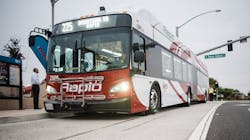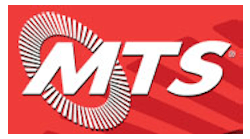San Diego region’s Bus on Shoulder pilot program driver training begins
A joint effort between the San Diego Association of Governments (SANDAG), San Diego Metropolitan Transit System (MTS), Caltrans, in partnership with the California Highway Patrol (CHP), will see Rapid bus service operate on the shoulder of I-805 and SR 94 during peak travel times.
The Bus on Shoulder pilot project will see specially trained bus operators driving vehicles on designated freeway shoulders between National City and downtown San Diego. The three-year pilot project achieved a milestone with driver training commencing.
MTS bus operators on Route 225 will complete on-the-road training in December and January, with operations for the Bus on Shoulder project expected to begin in late January or early February. CHP will escort each bus during training and project stakeholders urge people driving on the freeway to remain alert, observe traffic safety laws and posted signage and never follow the bus into the shoulder.
Buses will only enter the freeway shoulder when travel lanes operate under 35 miles per hour (mph) and will travel at a maximum speed of 35 mph on the shoulders. The shoulders will always be available for law enforcement, emergencies and incident management.
The pilot project features the first use of vehicle-to-infrastructure technology in the San Diego region, which allows buses to communicate with ramp meters. The buses will be outfitted with driver assistance technology, including sensors that monitor the lanes and provide audio and visual alerts to the bus drivers to help avoid potential conflicts.
The $30.9 million pilot project includes $17 million for new Rapid buses. Additionally, SANDAG and Caltrans crews completed construction to modify freeway ramps and shoulders and install connected vehicle technology on I-805 and SR 94 in summer 2021. Crews also repaved sections of the shoulders and added striping and new signage along the route on I-805 and SR 94.
The Bus on Shoulder project will allow SANDAG, MTS and Caltrans to document on-time performance data, travel speeds, connected vehicle (vehicle-to-infrastructure) and driver assistance technology use, enforcement issues and rider and driver perceptions of the service to help inform future projects.
Mass Transit Staff Report
Stories under this byline were produced through a team effort by the editorial staff of Mass Transit.
To learn more about our team, click here.
If you have a story idea, let us know by emailing [email protected]. Please review our contributor guidelines found here.




